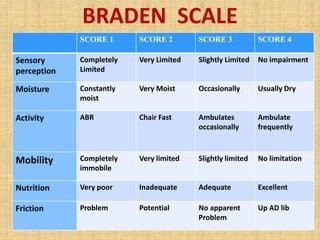A nurse is completing a risk assessment on a new admission. Which standardized scale will the nurse use to calculate the client's risk for pressure ulcers?
Morse Scale
Braden Scale
Bristol Scale
Hendrich II scale
The Correct Answer is B
A. Morse Scale:
The Morse Scale, also known as the Morse Fall Scale, is used to assess a patient's risk of falling. It evaluates various factors such as history of falling, secondary diagnosis, ambulatory aids, IV therapy, gait, and mental status. It is primarily focused on assessing the risk of falls, not pressure ulcers.
B. Braden Scale:
As previously mentioned, the Braden Scale assesses a patient's risk for developing pressure ulcers. It takes into account sensory perception, moisture, activity, mobility, nutrition, and friction/shear. The scale helps healthcare providers determine the level of risk a patient has for developing pressure sores and guides interventions to prevent them.
C. Bristol Scale:
The Bristol Stool Scale is used to classify the form of human feces into seven categories. It is a medical aid designed to classify the form of human feces into seven categories. This scale is primarily used to assess bowel movements and is unrelated to pressure ulcers.
D. Hendrich II Scale:
The Hendrich II Fall Risk Model is a tool designed to identify patients at risk for falls. It includes factors such as confusion, symptomatic depression, altered elimination, dizziness, male gender, and the use of antiepileptics, benzodiazepines, or non-opioid analgesics. Similar to the Morse Scale, it focuses on assessing the risk of falls, not pressure ulcers.

Nursing Test Bank
Naxlex Comprehensive Predictor Exams
Related Questions
Correct Answer is B
Explanation
A. Foam:
Explanation: Foam dressings are highly absorbent and provide cushioning and protection to wounds. They are suitable for wounds with moderate to heavy drainage. While foam dressings are excellent for wound exudate management, they are not specifically designed for protecting bony prominences or areas with poor skin integrity.
B. Non-adherent:
Explanation: Non-adherent dressings are made from materials that do not stick to the wound bed. They are ideal for fragile skin, bony prominences, or superficial wounds where minimizing trauma during dressing changes is important. Non-adherent dressings are often used for preventing further skin damage in malnourished clients with poor skin integrity.
C. Ace bandage:
Explanation: Ace bandages, or elastic bandages, are primarily used for providing compression and support to injured joints or muscles. They are not designed for protecting bony prominences or fragile skin areas. Using an Ace bandage on a bony prominence could lead to pressure points and skin damage.
D. Hydrocolloid:
Explanation: Hydrocolloid dressings are absorbent and form a gel-like barrier when they come into contact with wound exudate. They provide a moist environment that supports healing and autolytic debridement. Hydrocolloid dressings are suitable for wounds with light to moderate drainage. While they are beneficial for certain wounds, they are not specifically indicated for protecting bony prominences in malnourished clients.

Correct Answer is ["A","C","E"]
Explanation
A. Client with restricted activity - Patients with limited mobility are at a higher risk for pressure ulcers because they are unable to change positions easily, leading to prolonged pressure on certain body parts.
B. Client who can ambulate - Patients who can ambulate have the ability to shift their body weight and change positions, reducing the risk of prolonged pressure on specific areas. Ambulation can improve circulation and reduce the risk of pressure ulcers
C. Client with a cast - Clients with casts are often limited in their ability to move or change positions, making them susceptible to pressure ulcers in areas where the cast creates pressure points on the skin.
D. Client with good nutrition - Proper nutrition is essential for overall health, including skin health. Adequate nutrition promotes wound healing and tissue repair. Good nutrition is not a risk factor for pressure ulcers; in fact, it can contribute to preventing them by maintaining healthy skin.
E. Client with urinary and fecal incontinence - Incontinence can lead to moisture on the skin, making it more susceptible to breakdown. Prolonged exposure to moisture, especially in the presence of urine or feces, can increase the risk of pressure ulcer development.
Whether you are a student looking to ace your exams or a practicing nurse seeking to enhance your expertise , our nursing education contents will empower you with the confidence and competence to make a difference in the lives of patients and become a respected leader in the healthcare field.
Visit Naxlex, invest in your future and unlock endless possibilities with our unparalleled nursing education contents today
Report Wrong Answer on the Current Question
Do you disagree with the answer? If yes, what is your expected answer? Explain.
Kindly be descriptive with the issue you are facing.
